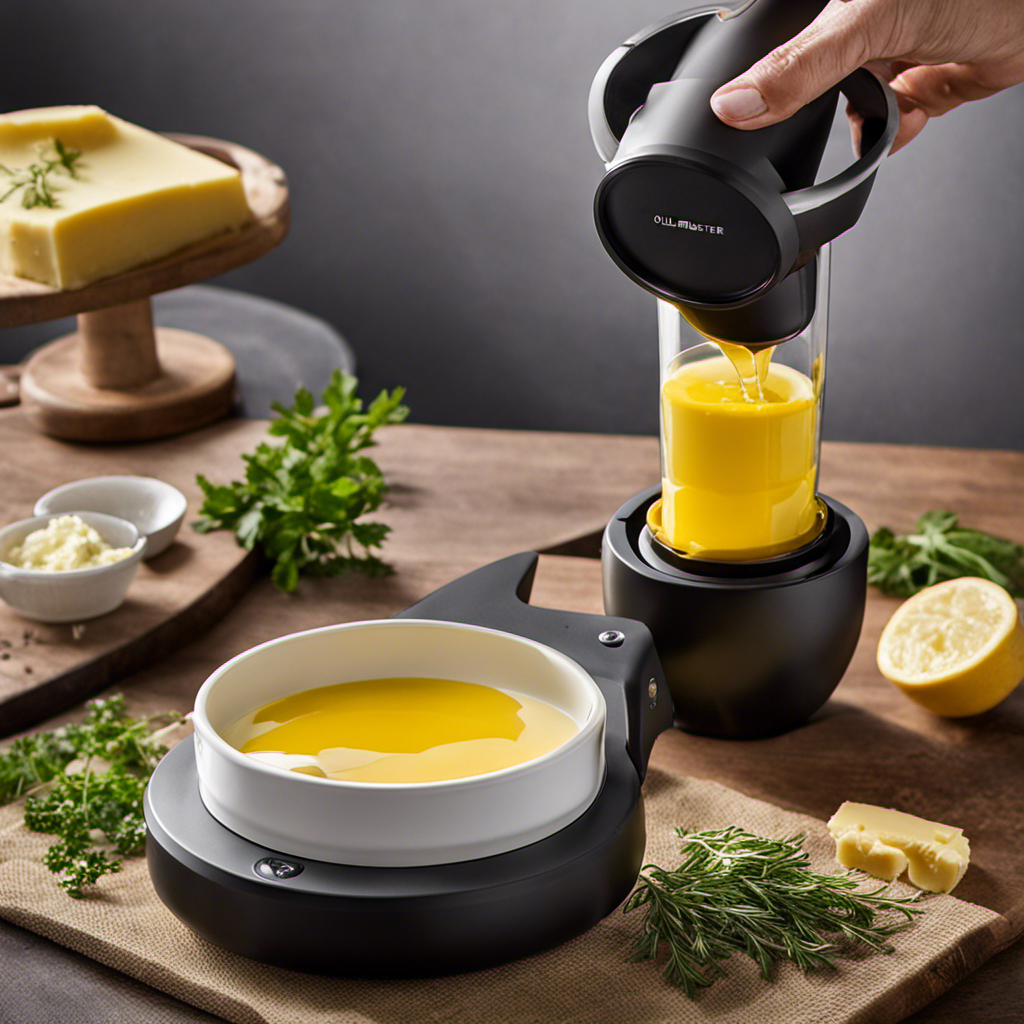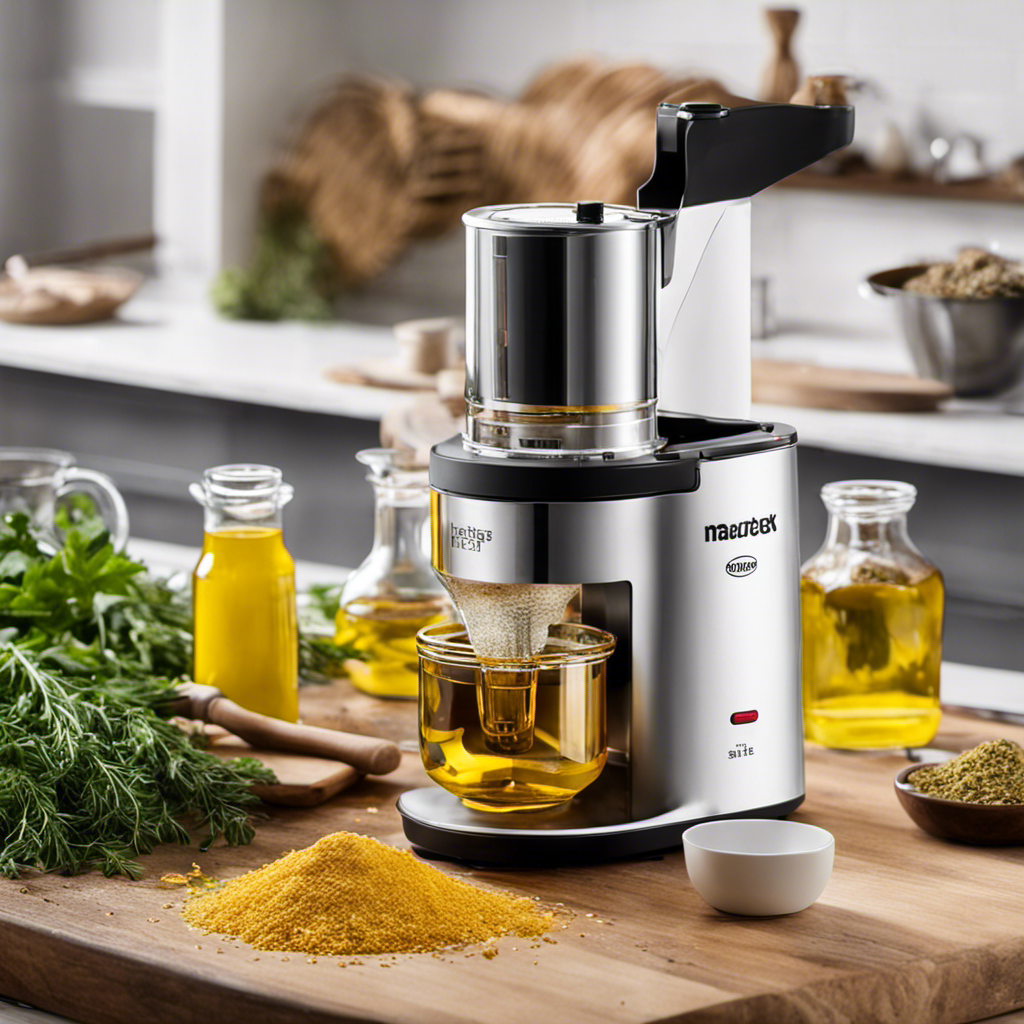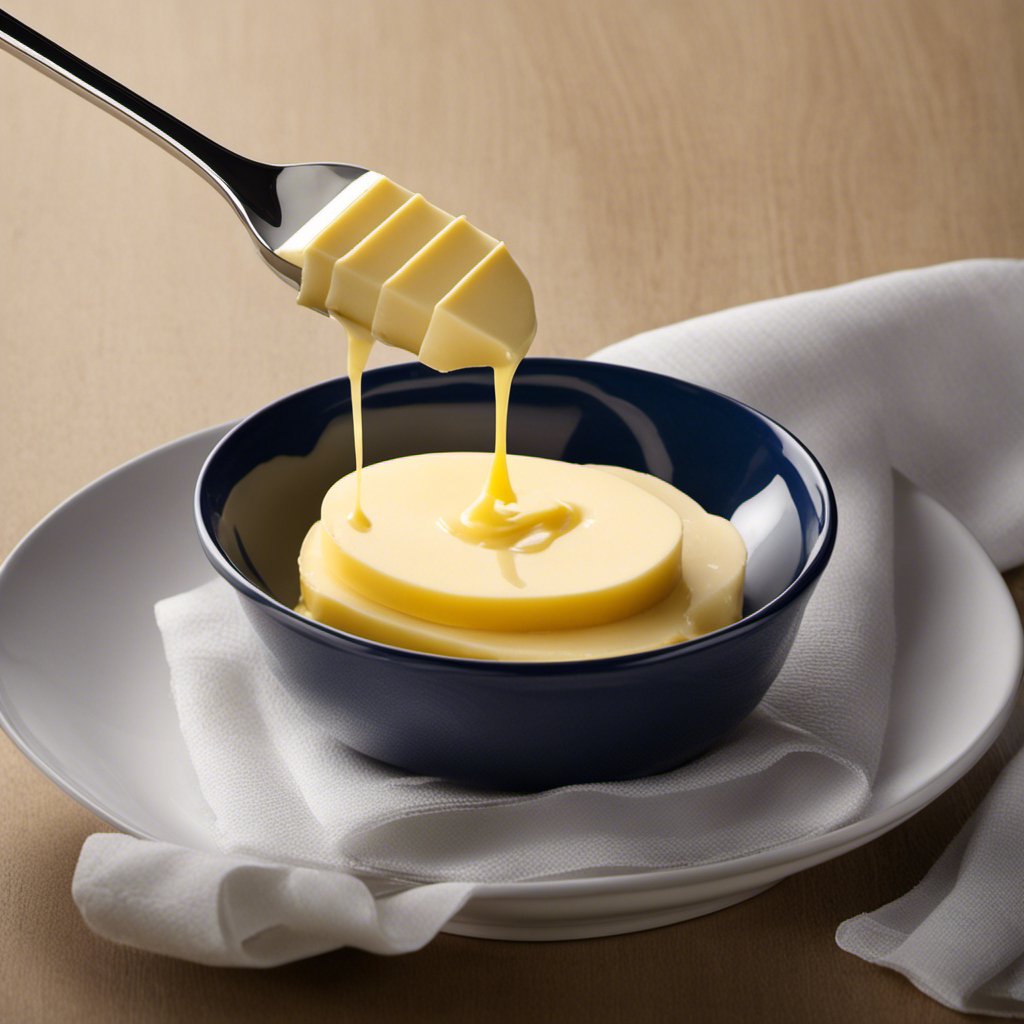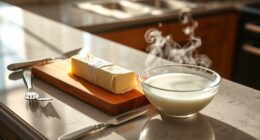Using the Easy Butter Maker is akin to possessing a magical culinary gadget that seamlessly converts ingredients into a tasty and powerful blend.
In this article, I’ll guide you through the step-by-step process of creating your own oil using this revolutionary device.
From choosing the right ingredients to infusing the oil with cannabis and adding delicious flavors, I’ll share my tips and tricks for achieving the best results.
Get ready to unlock the secrets of making oil with the Easy Butter Maker and elevate your culinary creations to new heights.
Key Takeaways
- Choosing the right ingredients and measuring ratios correctly is crucial for the best oil
- Efficient oil extraction methods are essential for optimal results
- Decarboxylate ingredients before extraction for best results
- Experiment with temperature and timing to find preferred flavor and potency
Choosing the Right Ingredients
To make the best oil with the Easy Butter Maker, you’ll want to choose the right ingredients. When it comes to making oil, there are alternatives to cannabis that can be used. Some popular options include lavender, chamomile, and rosemary. These alternatives can provide unique flavors and aromas to your oil.
Once you’ve decided on the main ingredient, it’s important to measure the ingredient ratios correctly. This will ensure that your oil turns out just the way you want it. The Easy Butter Maker comes with a measuring guide that helps you determine the right amount of ingredients to use. Following this guide will ensure that your oil is potent and flavorful.
In addition to the main ingredient, you may also want to consider adding other complementary herbs and spices to enhance the flavor of your oil. Some popular choices include thyme, basil, and garlic. Experimenting with different combinations can lead to incredible results.
Now that you know the importance of choosing the right ingredients and measuring the ratios correctly, let’s move on to preparing the Easy Butter Maker.
Preparing the Easy Butter Maker
When it comes to extracting oil efficiently, there are a few key methods that can yield optimal results. From using solvent extraction to cold pressing, each technique has its own advantages and considerations.
In this discussion, I will delve into these efficient oil extraction methods and provide you with valuable tips to achieve the best possible results in your oil-making endeavors.
Efficient Oil Extraction Methods
Using efficient extraction methods will help you maximize the amount of oil you can make with the easy butter maker. When dealing with low-quality ingredients, it becomes even more important to optimize your oil yield.
One effective method is to start by decarboxylating your ingredients. This process involves heating them at a low temperature to activate the cannabinoids and increase their potency. Once decarboxylated, you can proceed to the extraction stage.
I recommend using a high-quality solvent, such as food-grade ethanol, to extract the oil effectively. This solvent is able to separate the cannabinoids from the plant material, resulting in a more potent and flavorful oil.
Additionally, using a cold extraction method, such as the freezer or dry ice method, can further enhance your oil yield by reducing the loss of cannabinoids during the extraction process.
Tips for Optimal Results
For the best results, it’s important to decarboxylate your ingredients before proceeding with the extraction process.
Decarboxylation is the process of heating your cannabis or other ingredients at a specific temperature to activate their compounds.
To enhance the flavor and potency of your oil, it’s crucial to adjust the temperature correctly during decarboxylation.
The ideal temperature range for decarboxylation is between 220 to 240 degrees Fahrenheit (104 to 115 degrees Celsius).
This ensures that the cannabinoids and terpenes are activated without being degraded.
By adjusting the temperature within this range, you can maximize the flavor profile of your oil.
It’s also important to note that different strains may require slight temperature adjustments for optimal results.
Experimenting with temperature and timing will help you find your preferred flavor and potency.
Decarboxylating the Cannabis
When it comes to decarboxylating cannabis, it is important to understand the optimal temperature for this process. This temperature typically falls between 220-240°F (104-115°C) and allows for the conversion of THCA into THC, the compound responsible for the psychoactive effects of cannabis.
Additionally, even heating throughout the decarboxylation process is crucial to ensure that all parts of the cannabis are properly activated.
Lastly, it is worth noting that different cannabis strains may require slight variations in temperature and time for optimal decarboxylation, as the chemical composition can vary between strains.
Optimal Decarboxylation Temperature
To achieve the best results, you’ll want to set the optimal decarboxylation temperature for maximum potency.
Decarboxylation is a crucial step in making cannabis oil as it activates the cannabinoids, making them psychoactive.
Adjusting the decarboxylation temperature can significantly impact the potency of your oil.
The ideal temperature for decarboxylation is around 220 to 245 degrees Fahrenheit.
This temperature range ensures the complete conversion of THCA (tetrahydrocannabinolic acid) into THC (tetrahydrocannabinol), the compound responsible for the psychoactive effects.
Going below the optimal temperature may result in incomplete decarboxylation, leading to a less potent oil.
On the other hand, exceeding the temperature range can degrade the cannabinoids, reducing the overall potency.
Therefore, it is crucial to monitor and maintain the optimal decarboxylation temperature to maximize the potency of your cannabis oil.
Importance of Even Heating
Achieving even heating is essential for maximizing the potency of your cannabis oil. This ensures that all parts of the mixture are evenly decarboxylated. Consistent temperature throughout the decarboxylation process is crucial because different compounds in cannabis activate at different temperatures.
By using even heating techniques, such as stirring the mixture regularly or using a double boiler, you can ensure that the temperature remains consistent throughout the process. This consistency allows for a more efficient and thorough decarboxylation, resulting in a more potent and effective cannabis oil.
The benefits of consistent temperature include maximizing the conversion of THCA to THC, which is responsible for the psychoactive effects of cannabis. This ensures that you get the most out of your cannabis oil.
Now, let’s explore how to decarb different cannabis strains to optimize their unique properties.
Decarbing Different Cannabis Strains
Decarbing different cannabis strains is an important step in making oil with the Easy Butter Maker. It involves applying heat to activate the THC and other cannabinoids in the plant material. The temperature and time required for decarboxylation can vary depending on the strain of cannabis being used. To ensure optimal results, it’s crucial to adjust the temperature and time accordingly.
Here is a table showing the recommended temperature and time for decarbing different cannabis strains:
| Strain | Temperature (Fahrenheit) | Time (minutes) |
|---|---|---|
| Sativa | 240 | 40 |
| Indica | 220 | 60 |
| Hybrid | 230 | 50 |
Infusing the Oil With Cannabis
Once you have ground your cannabis, it’s time to infuse the oil. Infusing oil with cannabis is a crucial step in creating homemade cannabis-infused products. There are several different infusion techniques you can use, depending on your preferences and desired outcome. Here are three popular methods:
-
Stovetop method: This is the most traditional and commonly used technique. Simply combine your ground cannabis and oil in a pot or saucepan and heat it over low heat for a few hours. This method allows for more control over the temperature and infusion process.
-
Slow cooker method: If you prefer a hands-off approach, using a slow cooker is a great option. Place your ground cannabis and oil in the slow cooker and let it simmer on low heat for several hours. This method is convenient and ensures a consistent temperature throughout the infusion process.
-
Sous vide method: This technique involves using a precision cooker to maintain a specific temperature for an extended period. Simply seal your ground cannabis and oil in a vacuum-sealed bag and immerse it in a water bath controlled by the precision cooker. This method provides precise control over the temperature and results in a potent infusion.
Adding Flavor and Aroma
When it comes to enhancing taste with herbs, there are endless possibilities to explore. Whether it’s adding a hint of freshness with basil or a burst of earthiness with rosemary, herbs can take your dishes to the next level.
Additionally, infusing oils with spices can elevate the flavor profile of any dish. From the warmth of cinnamon to the boldness of cumin, these infused oils can add depth and complexity to your culinary creations.
Join me as we delve into the world of enhancing taste with herbs and infusing oils with spices, and discover how these simple techniques can transform your cooking.
Enhancing Taste With Herbs
To add more flavor to your oil, you can mix in herbs and spices. Infusing butter with different herbs is a great way to enhance its taste and make it more versatile in your cooking.
Here are three herbs that work particularly well for infusing butter:
-
Rosemary: This aromatic herb adds a savory and slightly woody flavor to butter. It pairs well with roasted meats and vegetables and can elevate simple dishes like mashed potatoes or grilled cheese sandwiches.
-
Basil: Known for its fresh and slightly sweet taste, basil adds a burst of flavor to butter. It is perfect for making herb-infused butter for pasta dishes, spreading on bread, or drizzling over grilled vegetables.
-
Thyme: With its earthy and slightly minty flavor, thyme is a popular choice for infusing butter. It complements roasted chicken, fish, and potatoes, and is also great for making compound butter for steaks or grilled seafood.
Infusing Oils With Spices
Using a variety of spices can enhance the flavor of your oils and add a unique twist to your dishes. Infusing oils with fruits and experimenting with different spices can take your culinary creations to the next level.
When infusing oils with fruits, it’s important to choose ripe and flavorful ones. Berries like strawberries and raspberries add a sweet and tangy note, while citrus fruits like oranges and lemons bring a refreshing and zesty taste.
To experiment with spices, start with familiar ones like garlic, ginger, or chili flakes for a savory kick. Then, venture into more exotic options like cardamom, cinnamon, or star anise for a hint of warmth and complexity.
Remember to let the oils sit for a few days to allow the flavors to meld together. With these creative infusions, you can elevate your dishes with a burst of flavor that will impress your guests.
Adjusting the Temperature and Time
The first step in adjusting the temperature and time is to ensure you have the correct settings on the easy butter maker. This is crucial for achieving optimal temperature control and maximizing oil yield. Here are three key points to keep in mind when adjusting the temperature and time:
-
Set the temperature accurately: The easy butter maker allows you to select a specific temperature range for infusing your oils. It is important to choose the right temperature to ensure that the active compounds in your ingredients are properly extracted. Different herbs and spices require different temperatures, so refer to the instructions or recipe for guidance.
-
Monitor the time: Time plays a significant role in the infusion process. It is important to follow the recommended time guidelines to extract the desired flavors and aromas from your ingredients. However, be cautious not to exceed the recommended time, as it may result in a bitter or unpleasant taste.
-
Experiment and adjust: Every ingredient and recipe is unique, so don’t be afraid to experiment and make adjustments to the temperature and time settings. Keep notes of your experiments to track what works best for different ingredients and flavors.
Straining the Oil Mixture
When it comes to making oil with the easy butter maker, proper straining techniques are essential to achieve a high-quality final product.
By using fine mesh strainers or cheesecloth, you can effectively filter out any impurities, such as plant matter or sediment, resulting in a cleaner and smoother oil.
Additionally, enhancing oil extraction can be achieved by gently pressing the mixture through the strainer to ensure maximum extraction of the desired compounds.
Proper Straining Techniques
To strain your oil properly, you’ll want to start by placing a fine mesh strainer over a heat-resistant container. This will ensure that any unwanted particles or impurities are removed from your oil, resulting in a clean and smooth final product.
Here are three essential equipment and techniques for proper straining:
-
Use a fine mesh strainer: A fine mesh strainer is necessary to catch even the tiniest particles in your oil. This will help you achieve a pure and clear oil.
-
Strain slowly and gently: Pour your oil mixture slowly through the strainer to allow for thorough straining. Avoid pressing or squeezing the mixture, as this can force impurities through the strainer.
-
Patience is key: Proper straining takes time, so be patient and let gravity do its work. Rushing the process can lead to incomplete straining and compromise the quality of your oil.
Filtering Out Impurities
Filtering out impurities is important in ensuring a clean and high-quality final product. By removing unwanted particles, we can enhance the flavor and improve the purity of our oil. To achieve this, I recommend using a fine mesh strainer or cheesecloth during the filtration process. These tools effectively trap any solids or debris, leaving behind a smooth and pure oil. Additionally, it is crucial to be patient and allow sufficient time for the oil to pass through the filter. Rushing this step may result in a less refined product. Remember, a little effort in filtering goes a long way in producing an oil that is not only visually appealing but also boasts a superior taste and quality.
Here is a helpful table to guide you through the process:
| Tools Needed | Steps to Follow |
|---|---|
| Fine mesh strainer or cheesecloth | 1. Place the strainer or cheesecloth over a clean container. |
| 2. Slowly pour the oil into the strainer or onto the cheesecloth. | |
| 3. Allow the oil to pass through the filter, leaving behind any impurities. |
Enhancing Oil Extraction
For an improved oil extraction process, you can enhance the flavor and quality of your final product by experimenting with different ingredients and techniques.
Here are three ways to enhance oil extraction efficiency and infuse oils with fruits:
-
Cold-Press Method: Use a cold-press technique to extract oils from fruits. This method helps retain the natural flavors and nutrients of the fruits, resulting in a more flavorful oil.
-
Sous Vide Infusion: Try infusing oils with fruits using a sous vide technique. This involves sealing the fruits and oil in a vacuum-sealed bag and cooking it at a precise temperature for an extended period. This allows the flavors to infuse into the oil thoroughly.
-
Herb and Fruit Combinations: Experiment with different combinations of herbs and fruits to create unique flavor profiles. For example, try infusing olive oil with lemon and rosemary for a zesty and aromatic oil.
Storing the Finished Oil
Once the oil is ready, it’s important to store it properly to maintain its freshness and potency. Proper storage techniques are crucial for prolonging the oil’s shelf life and preserving its quality. Here are some tips to help you store your homemade oil effectively:
| Technique | Description |
|---|---|
| Dark Glass Bottles | Store your oil in dark glass bottles to protect it from light exposure, which can cause oxidation and degradation of the oil. Amber or blue glass bottles are ideal as they block out harmful UV rays. |
| Cool, Dark Place | Keep your oil in a cool, dark place away from direct sunlight and heat sources. Exposure to heat and light can accelerate the breakdown of the oil, diminishing its flavor and potency. |
| Airtight Seal | Ensure that the bottles have a tight and secure seal to prevent air from entering. Oxygen can cause the oil to spoil and become rancid over time. |
| Avoid Oxygen Exposure | When using the oil, pour out only the required amount and promptly seal the bottle again. This minimizes oxygen exposure and helps preserve the oil’s freshness. |
| Refrigeration | If you live in a warm climate or if your oil has a high concentration of perishable ingredients, storing it in the refrigerator can help extend its shelf life. However, keep in mind that refrigerated oil may solidify, so allow it to come to room temperature before use. |
Understanding Different Strains of Cannabis
After learning about the importance of storing the finished oil, let’s now delve into understanding different strains of cannabis. This knowledge is crucial for anyone looking to maximize the THC content in their oil.
-
Indica: Indica strains are known for their relaxing and sedating effects. They often have higher levels of CBD, which can help with pain relief and promoting sleep. When dealing with moldy cannabis, it’s important to choose an indica strain that is resistant to mold and mildew.
-
Sativa: Sativa strains, on the other hand, are known for their energizing and uplifting effects. They typically have higher levels of THC, which can enhance creativity and focus. When dealing with moldy cannabis, it’s crucial to choose a sativa strain that has been properly dried and cured to prevent the growth of mold.
-
Hybrid: Hybrid strains are a combination of both indica and sativa genetics. They offer a balanced experience, with properties from both strains. When dealing with moldy cannabis, it’s essential to choose a hybrid strain that has been tested for mold and has a high THC content.
Exploring Alternative Ingredients
To enhance the flavor and potency of your cannabis-infused products, consider exploring alternative ingredients that can complement the effects of different strains.
One way to do this is by infusing oils with fruits. Fruits not only add a burst of flavor but also provide additional health benefits. For example, infusing olive oil with citrus fruits like oranges or lemons can add a refreshing and tangy taste to your infused products. Additionally, citrus fruits are rich in vitamin C, which can boost your immune system.
Another great fruit option is berries, such as strawberries or blueberries. These fruits are packed with antioxidants and can add a sweet and fruity twist to your cannabis-infused oils.
In addition to fruits, experimenting with different herbs can also elevate the taste and effects of your infused products. Herbs like mint or basil can provide a refreshing and aromatic flavor to your oils. Mint, in particular, has a cooling effect that can complement certain strains known for their relaxing properties. On the other hand, basil can add a savory and earthy note to your infused oils, enhancing the overall taste experience.
Troubleshooting Common Issues
If you’re experiencing common issues with your cannabis-infused products, there are a few troubleshooting tips that can help you resolve them.
-
Check your equipment: One of the most common issues with cannabis-infused products is equipment malfunction. Ensure that your infusion device, such as the Easy Butter Maker, is in good working condition. Check for any loose connections, broken parts, or clogs that may be affecting the infusion process. If you spot any issues, try cleaning or repairing the equipment before proceeding.
-
Monitor your temperatures: Temperature control is crucial when making cannabis-infused products. If you’re encountering problems with your infusion, it’s essential to check and calibrate your temperature settings. Ensure that your device is maintaining the correct temperature throughout the entire process. Fluctuations or incorrect temperatures can affect the potency and consistency of your final product.
-
Evaluate your ingredients: Another factor that can contribute to infusion problems is the quality and consistency of your ingredients. Make sure you’re using high-quality cannabis and other ingredients that are fresh and free from contaminants. Additionally, ensure that you’re using the right ratio of ingredients for your desired potency. Adjusting the quality and quantity of your ingredients can significantly impact the success of your infusion.
By troubleshooting equipment issues, monitoring temperatures, and evaluating ingredients, you can overcome common problems encountered when making cannabis-infused products.
Remember to follow these tips to achieve consistent and satisfying results.
Understanding the Effects and Potency
Understanding the effects and potency of cannabis-infused products can help you make informed decisions about consumption. When it comes to cannabis-infused products, it’s important to understand that the effects can vary depending on various factors such as dosage and the method of infusion.
Dosage is crucial because it determines the intensity of the effects you will experience. It’s always best to start with a low dose and gradually increase it until you find the desired effect.
Experimenting with infusion methods is also key to understanding the potency of cannabis-infused products. Different methods, such as using butter or oil, can result in different levels of potency. For example, using butter may result in a slower onset of effects, while using oil may have a quicker onset.
By exploring different infusion methods, you can find the one that works best for you and your desired effects.
Now that we have a better understanding of the effects and potency of cannabis-infused products, let’s dive into exploring different extraction methods.
Exploring Different Extraction Methods
Exploring different extraction methods can help you find the most effective way to create cannabis-infused products. When dealing with limited resources, it’s important to consider organic extraction methods that are both efficient and sustainable. Here are three methods worth exploring:
-
Supercritical CO2 extraction: This method uses carbon dioxide in its supercritical state to extract cannabinoids from the plant material. It is a clean and efficient process that produces high-quality extracts. However, it requires specialized equipment and can be expensive to set up.
-
Ethanol extraction: This method involves soaking the plant material in ethanol to dissolve the cannabinoids. It is a cost-effective and widely used method that can be done at home with basic equipment. However, it requires careful monitoring of temperature and time to avoid extracting unwanted compounds.
-
Rosin pressing: This method involves applying heat and pressure to the plant material to extract the cannabinoids. It is a simple and DIY-friendly method that doesn’t require any solvents. However, it may not be as efficient as other methods and may not yield as high-quality extracts.
Using the Oil in Cooking and Baking
To incorporate the infused oil into your cooking and baking, you can simply substitute it for regular oil or butter in your recipes. The possibilities are endless when it comes to using the oil in your culinary creations. The rich, herb-infused flavors can add depth and complexity to your dishes. Whether you’re sautéing vegetables, roasting meats, or baking desserts, the infused oil can elevate your recipes to a whole new level.
But the uses of this oil don’t stop at the kitchen. The infused oil can also be used for skincare and medicinal purposes. The natural properties of the herbs can provide nourishment and hydration to your skin, leaving it feeling soft and supple. Additionally, the oil can be used topically to soothe minor skin irritations or as a massage oil for relaxation and pain relief.
Now that you know the various uses of the infused oil, let’s move on to some tips and tricks for making the best oil.
Tips and Tricks for Making the Best Oil
Now that you’ve mastered the art of infusing oil with herbs, let’s dive into some helpful tips and tricks for creating the most flavorful and aromatic concoctions. To ensure the best results, it’s important to understand decarboxylation techniques and how to store your oil properly.
Here are three key tips to take your oil-making skills to the next level:
-
Decarboxylation: Before infusing your oil, it’s crucial to activate the cannabinoids in your herbs through decarboxylation. This process involves heating your herbs at a low temperature to convert the non-psychoactive THCA into the psychoactive THC. This step ensures that your oil will be more potent and effective.
-
Temperature control: When infusing your oil, maintaining the right temperature is essential. Too high of a temperature can cause the cannabinoids to degrade, resulting in a less potent oil. It’s best to use a double boiler or a slow cooker to gently heat your oil and herbs without overheating.
-
Proper storage: To keep your oil fresh and flavorful, it’s important to store it properly. Use dark, airtight glass containers to protect your oil from light and oxygen. Store it in a cool, dark place, away from direct sunlight and heat. This will help to preserve the potency and quality of your infused oil.
Frequently Asked Questions
Can I Use Any Type of Oil in the Easy Butter Maker?
Yes, you can use different types of oil in the Easy Butter Maker. Each oil has its own unique benefits when used for infusing. It’s important to choose the right oil based on your desired outcome.
How Long Does It Take to Decarboxylate Cannabis?
Decarboxylation is a crucial step in making cannabis oil. It converts THCA, a non-psychoactive compound, into THC, which gives you the desired effects. The process usually takes about 1-2 hours at 220-240°F.
Can I Use Different Strains of Cannabis to Infuse the Oil?
Yes, you can use different strains of cannabis to infuse the oil. It allows you to experiment with flavors and effects. Adjusting the potency is possible by adjusting the amount of cannabis used in the infusion process.
How Do I Know if the Oil Is Properly Strained?
When straining oil, it’s important to achieve the right consistency. I strain my oil by using a fine mesh strainer or cheesecloth to remove any plant matter. If the oil isn’t properly strained, I re-strain it to ensure a smooth and pure final product.
Can I Store the Finished Oil in the Refrigerator?
Yes, you can store the finished oil in the refrigerator, but it’s best to store it at room temperature for optimal freshness and taste. Glass jars or airtight containers are the best options for storing oil.
Conclusion
In conclusion, making oil with the Easy Butter Maker is a simple and efficient process. It allows you to enjoy the benefits of cannabis-infused oil in your cooking and baking. With the right ingredients and proper techniques, you can create a flavorful and potent oil. This oil will elevate your culinary creations. Just like a skilled chef adds the perfect amount of spice to a dish, you can now add a touch of cannabis oil. This will elevate your recipes to a whole new level of deliciousness. So go ahead, unleash your inner chef and start creating your own cannabis-infused masterpieces!










